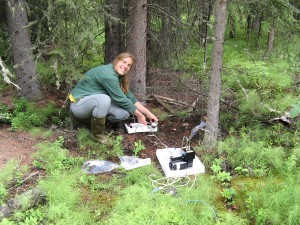 The Center for Global Change Science provides a framework and focal point for the exchange of interdisciplinary ideas and information relevant to global change science, with a broad and integrated program of education in the earth, atmospheric, oceanographic, and climate sciences. CGCS is NOT a degree-granting entity.
The Center for Global Change Science provides a framework and focal point for the exchange of interdisciplinary ideas and information relevant to global change science, with a broad and integrated program of education in the earth, atmospheric, oceanographic, and climate sciences. CGCS is NOT a degree-granting entity.
Students interested in global change science are encouraged to apply to the academic department that matches closest their own interests. Two recommended options are Earth, Atmospheric, and Planetary Sciences and the Civil and Environmental Engineering.
The basic disciplines of global change science are physics, chemistry, mathematics and biology, but much of the research is interdisciplinary, involving many topics and various types of methodologies or laboratory techniques. Although students tend to pursue a special topic in depth, they are especially encouraged to venture beyond their primary field to understand the broader context of their work. And since there are common examination procedures and degree requirements, students can, if necessary, shift their focus from one specialty to another as interests develop. Successful studies in global change science will give students the ability to bridge standard disciplinary gaps.
Courses offered at MIT are described in the online Subject Listings and Schedule. The online Bulletin provides a complete list of subjects offered, as well an overview of campus life and the academic structure and organization of the Institute. The Bulletin, application information, and more information, are available from the Admissions Office. To get an idea as to the wide variety of courses offered on campus in areas related to environmental science, environmental policy and environmental sustainability, there is a list of environmental classes at MIT.
Graduate Students
 Specific fields for graduate study include, but are not limited to, such areas as atmospheric science, oceanography, climate physics and chemistry, environmental fluid dynamics, aquatic science, and hydrology. Several recommended graduate degree pathways are in the Program in Atmospheres, Oceans and Climate (PAOC), which is in the department of Earth, Atmospheric, and Planetary Sciences (EAPS). Other suggested graduate programs are found within the department of Civil and Environmental Engineering (CEE).
Specific fields for graduate study include, but are not limited to, such areas as atmospheric science, oceanography, climate physics and chemistry, environmental fluid dynamics, aquatic science, and hydrology. Several recommended graduate degree pathways are in the Program in Atmospheres, Oceans and Climate (PAOC), which is in the department of Earth, Atmospheric, and Planetary Sciences (EAPS). Other suggested graduate programs are found within the department of Civil and Environmental Engineering (CEE).
There are several graduate degree options in these areas, including doctoral (Ph.D. & Sc.D.), and master’s (S.M., M.Engr.) degrees. Degree programs in many other departments can also be tailored to involve CGCS participation and to match individual interests. Graduate study in atmospheric science, oceanography, and climate physics & chemistry is overseen by PAOC. The physical oceanography program is conducted in cooperation with the Woods Hole Oceanographic Institution (WHOI). Degree programs in hydrology, environmental chemistry & biology, and environmental fluid mechanics & coastal engineering are offered in CEE.
Recognizing the need to encourage more students to pursue interdisciplinary training, CGCS provides several students with financial support in the form of research fellowships. CGCS helps support several graduate fellows participating in the modeling of the physical and aerobiogeochemical processes involved in climate change, through the Center’s Climate Modeling Initiative. Graduate student support is also provided in the form of research fellowships from the Joint Program on the Science and Policy of Global Change, and an environmental sustainabilityprogram.
Undergraduate Students
 There are several suggested academic undergraduate programs leading to Bachelor of Science (S.B. or B.S.) degrees at MIT that can effectively accomodate interests in climate and environmental studies. For example, the Department of Earth, Atmospheric and Planetary Sciences (EAPS) and its Program on Atmospheres, Oceans and Climate (PAOC) offer degrees in Atmospheres, Oceans & Climate and Environmental Science, both of which expose students to a wide range of earth science topics, while allowing the flexibility to choose a specific area of focus. Similarly, the Department of Civil and Environmental Engineering (CEE) degree in Environmental Engineering provides a solid understanding of and ability to apply the fundamentals of the physical, chemical and biological sciences, treatment and control, economics, and public policy, as they relate to environmental engineering. A bacherlor’s degree from either EAPS or CEE provides an excellent foundation for graduate study and research in both basic and applied environmental science and engineering disciplines. Both major and minor degree programs are offered by CEE and EAPS.
There are several suggested academic undergraduate programs leading to Bachelor of Science (S.B. or B.S.) degrees at MIT that can effectively accomodate interests in climate and environmental studies. For example, the Department of Earth, Atmospheric and Planetary Sciences (EAPS) and its Program on Atmospheres, Oceans and Climate (PAOC) offer degrees in Atmospheres, Oceans & Climate and Environmental Science, both of which expose students to a wide range of earth science topics, while allowing the flexibility to choose a specific area of focus. Similarly, the Department of Civil and Environmental Engineering (CEE) degree in Environmental Engineering provides a solid understanding of and ability to apply the fundamentals of the physical, chemical and biological sciences, treatment and control, economics, and public policy, as they relate to environmental engineering. A bacherlor’s degree from either EAPS or CEE provides an excellent foundation for graduate study and research in both basic and applied environmental science and engineering disciplines. Both major and minor degree programs are offered by CEE and EAPS.
It is recommended that in-coming Freshmen explore the Terrascope program, regardless of the expected academic departmental affiliation (undergraduates usually do not declare a major until their second year of study). Terrascope provides opportunities for first-year students to explore basic science and engineering concepts through the study of Planet Earth. High school students accepted for undergraduate study at MIT are encouraged to apply for participation in the program during the summer before arrival at the Institute.
All MIT undergraduate students are strongly encouraged to become involved in research through the Undergraduate Research Opportunities Program (UROP). Several undergraduate researchopportunities for hands-on field studies and laboratory work are available.


